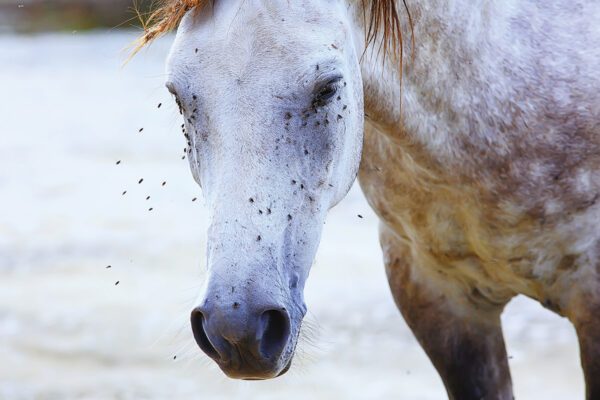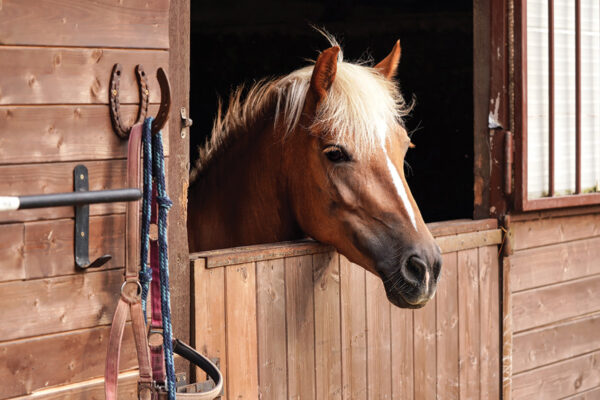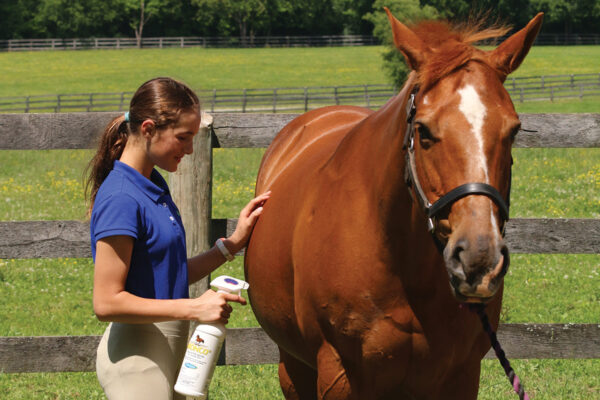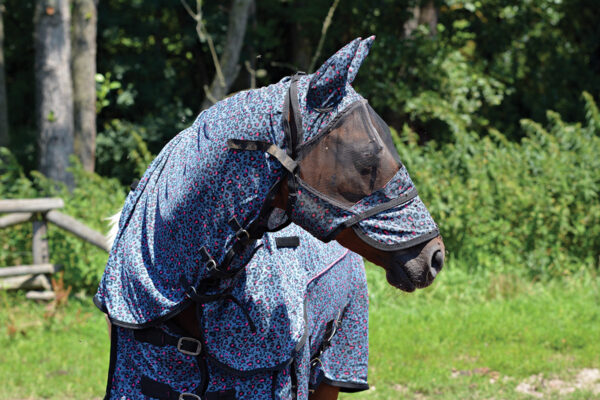
Summer is here, and so are the flies. These tiny pests are a huge annoyance to horses. They buzz and bite and can also spread some serious diseases. By using a combination of fly control methods, you can target flies at the barn, around the farm, and on your horse. Here are some ways to fight back against flies in each of these areas.
Fly Control for the Barn
Keeping a clean barn is one of the simplest things you can do to discourage flies. Manure is the main attraction for flies, so stay on top of cleaning stalls, runs and pens. The manure pile should be located as far away from the barn as possible. A good manure management strategy is essential to keep flies out of the barn.
In addition to manure, flies love moist areas, damp bedding, spoiled hay, garbage, and pretty much anything dirty or decaying. Sweep up spilled grain, hay and leftover feed so that it doesn’t become a fly buffet. Don’t leave trash around the barn, and if possible, use trash cans with lids. Scrub buckets and water troughs so they stay clean.
Well-placed fly traps can also help control flies around the barn. Most traps are designed to attract flies, so place these outside the barn or on the edge of the property to lure flies away from the barn and your horses. Sticky traps can catch those stray flies buzzing around inside the barn or tack room.
During fly season, you may opt to adjust your horse’s turnout schedule to stay in the cool, shady barn when flies, gnats and mosquitoes are most active outdoors. Stall fans can also help keep flying insects away from the horses.

A Fly-Free Farm
A great way to cut down on the fly population around your horse’s home is to stop more flies from hatching. If you begin this type of fly control early in the season, you’ll have a head start on a fly-free farm.
Feed-Through Fly Control: Fed daily, these fly control supplements prevent fly larvae in the manure from developing into adult flies. Feed-through fly control works best if all the horses on the farm are on it during fly season.
Good Bugs vs. Bad Bugs: You can also deploy an army of friendly insects to help battle flies on the property where your horse lives. Tiny little insects known as fly parasites are sold under a variety of brand names. These beneficial bugs lay their eggs inside fly pupae and kill the developing flies before they emerge. Simply release your fly parasites around the manure pile and other places where flies are likely to breed and let them go to work! You’ll need to release more throughout the season to keep ahead of the flies.
Fly Control for Your Horse
The flies that pester your pony cause plenty of tail swishing, foot-stomping and head-shaking. Here are some things you can do to avoid these annoyances and create a no-fly zone around your horse.
Fly Repellent: Fly spray is easy to apply and offers instant protection for your horse. There are many formulas to choose from that repel and even kill flies that dare come near your horse.

Read the label to see which insects and fly species the product targets, and if it includes the ones you are dealing with. House flies and biting stable flies are the most common winged pests bugging horses. Mosquitoes and ticks are also a concern because of the diseases they can spread. Depending on the season and where you live, there may be other types of gnats and flies around as well.
Fly spray works best on a clean coat, so brush off any mud, dust and loose hair first. Also, be sure you are applying enough fly spray! Read the directions for the recommended amount. In general, it should be enough to dampen (but not soak) your horse’s coat.
Use a cloth to apply to the face and be careful to avoid the area above the eyes, where it could drip down. Roll-ons, wipes and lotion formulas work great for ears, faces and sensitive areas. Ointments can be slathered on wounds or around tender skin.
Long lasting, sweat- and water-resistant fly sprays are good for horses out on pasture where it is difficult to reapply often, or for horses working up a sweat. Other fly sprays have bonus ingredients for shine and coat conditioning. For a gentler approach, you may like a natural formula with essential oils. When using a new fly spray for the first time, test it on a small area to make sure it doesn’t irritate your horse’s skin.
Fly-wear: Mesh fly masks, sheets and leg wraps create a lightweight protective barrier to keep flies from landing on your horse. Many of these provide sun protection as well.

Fly masks shield your horse’s eyes from insects as well as dust and debris. There are mask styles that also include ear coverings and extended nose covers to protect more of your horse’s face.
Make sure the mask fits your horse well. There should be plenty of room around the eye area. Keep your horse’s fly mask clean and remove it daily to check for rubs and make sure it’s still fitting comfortably.
A crocheted ear bonnet or fly mask designed for riding can help keep your ride fly-free.
Fly sheets come in a variety of styles, including neck covers and belly wraps for full coverage. Add mesh leg wraps to protect your horse’s legs from biting flies.
Fly Control Supplements: Protect your horse from the inside out with insect-defense supplements. Ingredients like garlic, brewer’s yeast and apple cider vinegar may help make your horse less appealing to flies.
With these fly control methods, you and your horse can enjoy a fly-free summer.
This article about fly control appeared in the July/August 2022 issue of Young Rider magazine. Click here to subscribe!


